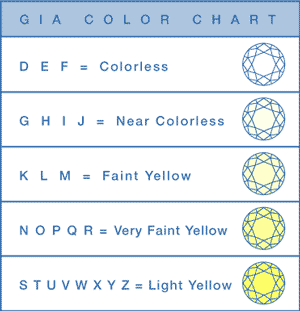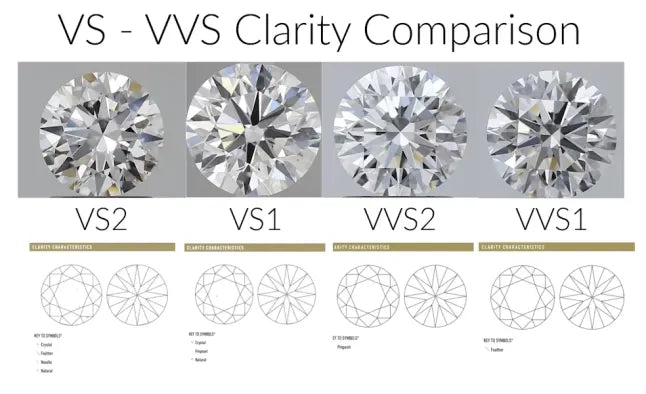While often associated with sparkling brilliance, diamonds exhibit a subtle range of colors that can significantly impact their beauty and value. Understanding diamond color allows you to make an informed decision and select a stone that truly captivates your eye.
The Diamond Color Scale

Diamonds are graded on a color scale established by the Gemological Institute of America (GIA), ranging from D to Z:
- D-F: Colorless: These diamonds are the most rare and valuable, exhibiting exceptional brilliance and transparency.
- G-J: Near Colorless: These diamonds have slight hints of color that are barely noticeable to the untrained eye. They offer excellent value and brilliance.
- K-M: Faint Yellow: These diamonds have a more noticeable yellow tint. While less valuable than higher color grades, they can still be beautiful and affordable options.
- N-R: Very Light Yellow: These diamonds have a distinct yellow hue.
- S-Z: Light Yellow: These diamonds have a noticeable yellow color.
It's important to view diamonds under controlled lighting conditions to accurately assess their color. A diamond's color can appear differently depending on the surrounding environment and the type of lighting used.
How Color Affects Diamond Brilliance
A diamond's color influences how light interacts with its facets, affecting its overall brilliance and sparkle. Colorless diamonds allow light to pass through them more freely, resulting in exceptional fire and scintillation. As the color grade decreases and the yellow tint becomes more pronounced, the diamond's ability to reflect light diminishes.
However, it's important to note that cut quality plays a crucial role in a diamond's brilliance. A well-cut diamond, even with a lower color grade, can exhibit remarkable sparkle and fire.
Choosing the Right Diamond Color
Selecting the perfect diamond color is a matter of personal preference and budget. Here are some factors to consider:
- Setting Metal: The color of the ring's metal can influence how the diamond's color appears. White gold or platinum settings tend to enhance the whiteness of a diamond, while yellow gold settings can make slight yellow tints less noticeable.
- Personal Preference: Some individuals prefer the icy whiteness of colorless diamonds, while others find warmer tones more appealing. Consider your personal taste and the overall aesthetic you desire.
- Budget: Colorless diamonds are the most rare and expensive. Near-colorless diamonds offer excellent value and brilliance, while diamonds with faint yellow tints can be more affordable options.
- Diamond Shape and Size: Color is more easily perceived in larger diamonds and certain shapes, such as emerald cuts. Smaller diamonds and brilliant cuts tend to mask color variations.
Beyond the D-to-Z Scale: Fancy Color Diamonds

While the D-to-Z scale grades the subtle color variations in white diamonds, there's a whole world of vibrant hues beyond this range. Fancy color diamonds occur naturally in a spectrum of colors, including pink, blue, yellow, green, and red. These diamonds are extremely rare and highly sought after, commanding premium prices.
Fancy color diamonds are graded on a separate color scale, taking into account the intensity and saturation of the color. The most valuable fancy color diamonds exhibit vivid and intense hues.
Tips for Evaluating Diamond Color
- View Diamonds Under Controlled Lighting: Reputable jewelers use standardized lighting conditions to accurately assess diamond color. Avoid evaluating diamonds under fluorescent lighting or in direct sunlight, as these can distort color perception.
- Compare Diamonds Side-by-Side: Compare diamonds with different color grades to see the subtle variations. This will help you determine which color range appeals to you most.
- Consider the Diamond's Cut: A well-cut diamond will exhibit exceptional brilliance, even if it has a lower color grade. Focus on the overall sparkle and fire of the diamond.
- Consult a Reputable Jeweler: A knowledgeable jeweler can guide you through the diamond selection process, explaining the nuances of color and helping you find a stone that meets your needs and preferences.
- Review the Diamond Certificate: Always request a diamond certificate from a reputable grading laboratory, such as GIA or IGI. This certificate provides an unbiased assessment of the diamond's color and other characteristics.
Conclusion
Diamond color is a fascinating and complex aspect of these precious gemstones. By understanding the color scale, how color affects brilliance, and the factors to consider when choosing a diamond, you can confidently select a stone that reflects your individual style and budget. Whether you're captivated by the icy whiteness of a colorless diamond or the vibrant hues of a fancy colored gem, your diamond will be a cherished symbol of your discerning taste and enduring love.






